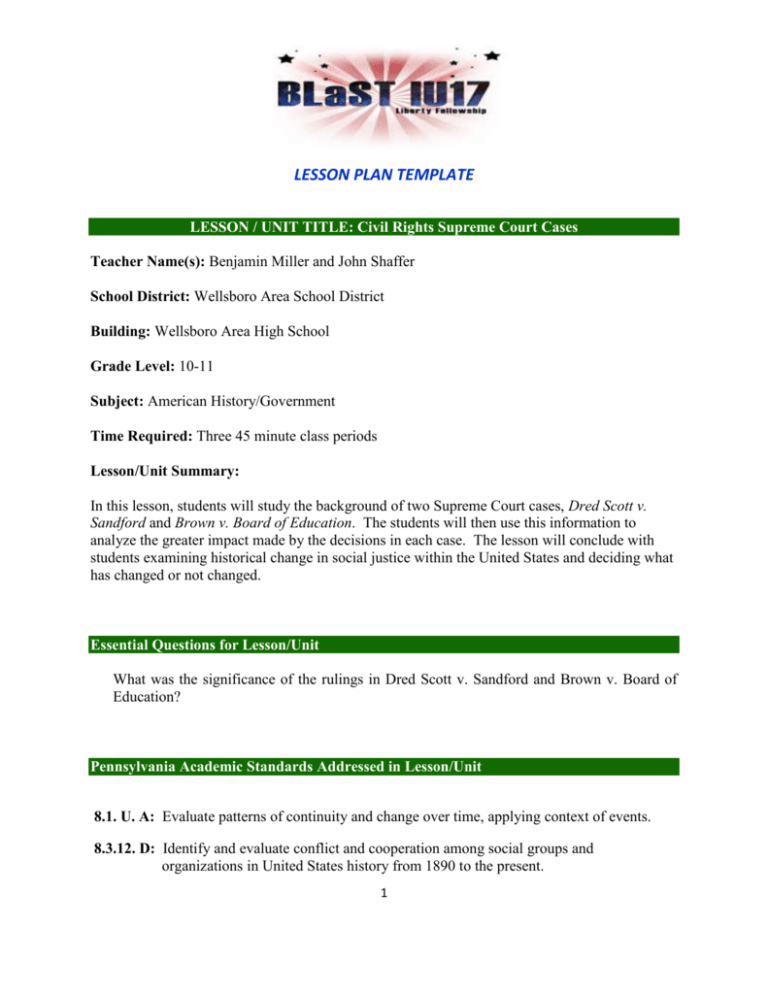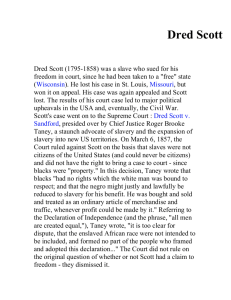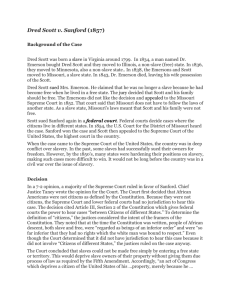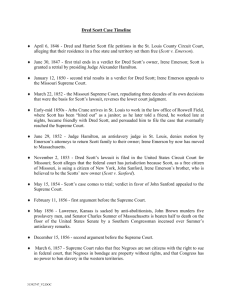Civil Rights SCOTUS Cases: Dred Scott vs Sandford and Brown vs
advertisement

LESSON PLAN TEMPLATE LESSON / UNIT TITLE: Civil Rights Supreme Court Cases Teacher Name(s): Benjamin Miller and John Shaffer School District: Wellsboro Area School District Building: Wellsboro Area High School Grade Level: 10-11 Subject: American History/Government Time Required: Three 45 minute class periods Lesson/Unit Summary: In this lesson, students will study the background of two Supreme Court cases, Dred Scott v. Sandford and Brown v. Board of Education. The students will then use this information to analyze the greater impact made by the decisions in each case. The lesson will conclude with students examining historical change in social justice within the United States and deciding what has changed or not changed. Essential Questions for Lesson/Unit What was the significance of the rulings in Dred Scott v. Sandford and Brown v. Board of Education? Pennsylvania Academic Standards Addressed in Lesson/Unit 8.1. U. A: Evaluate patterns of continuity and change over time, applying context of events. 8.3.12. D: Identify and evaluate conflict and cooperation among social groups and organizations in United States history from 1890 to the present. 1 LESSON PLAN TEMPLATE Lesson/Unit Objectives Students will be able to: 1. compare and contrast the Dred Scott and Brown Supreme Court decisions. 2. research and present a court case. 3. apply knowledge to small group and class discussions. 4. make connections between past SCOTUS cases and current events. Vocabulary/Key Terms for Lesson/Unit segregation social injustice Supreme Court appeals court opinions justice precedent Historical Background for Teachers / Research Narrative The Supreme Court and Civil Rights: Landmark Decisions The Supreme Court has the ability to make wide sweeping decisions through the rulings they make on specific cases. Twice the Supreme Court drastically affected the atmosphere towards AfricanAmericans in the United States. The two Supreme Court cases, Dred Scott v. Sandford (1857) and Brown v. Board of Education (1954) offer examples as to how, in less than a hundred years, the United States changed attitudes towards blacks but also how the Supreme Court changed the greater climate of the country. The Dred Scott case focused on the issue of whether a former slave had the right to sue in the court system. Dred Scott was a slave who lived on a cotton plantation, owned by Peter Blow, in Virginia. In 1831, Scott was sold to help pay off his owner’s bills. His new owner, Dr. Emerson, was a doctor in the army. Emerson moved his family to Wisconsin and Illinois. Eventually, the Emerson family made their way back to Missouri to live. Emerson died in 1843 at just 40 years old. Scott and his family tried to buy their freedom from Irene, Dr. Emerson’s wife, but she refused and continued to hire them out. 2 LESSON PLAN TEMPLATE After Scott arrived back in Missouri, he became aware of the Missouri Compromise, which stated specific rules for where slavery was allowed. Scott had been taken to the free areas of Illinois and Wisconsin. He believed that meant that he was free, he though he returned to the pro slave state of Missouri. On April 6, 1846, the case went to court. Scott sued Mrs. Emerson for false imprisonment. On January 12, 1848, a judge declared that Scott was free. Mrs. Emerson appealed the decision and the Missouri Appeals Court held a new trial and ruled that Scott was not free. The issue was eventually appealed to the federal district court and finally the Supreme Court. On March 6, 1857, the Supreme Court declared that Scott was not a citizen of the United States and therefore could not take part in the United States court system. This upheld the district court ruling that Dred Scott was still a slave. Chief Justice Roger B. Taney along with six other members of the court originated from pro-slavery states. The Dred Scott case gave them an opportunity to make a major statement involving slavery in general. The Court ruled that the Missouri Compromise of 1820 was unconstitutional and that Congress had no legal right to regulate slavery. The Dred Scott case helps to shed light into how confusing the rules for citizenship were for African Americans in the 1850’s. It also is an example of how powerful the Supreme Court can be in shaping national politics, the Dred Scott decision is one of the main causes of the Civil War. The Dred Scott decision is not the only example of the Supreme Court taking a case dealing with a race issue and making a wide sweeping decision. Almost one hundred years after Dred Scott, the court case Brown v. Board of Education would drastically change the United States. Brown v. Board of Education centers around nine year-old Linda Brown of Topeka, Kansas. Linda was an African-American living in a segregated area of Topeka. Even though she lived and befriended both black and white kids, she was forced to attend a segregated black school that was miles from her home. Her father, Oliver Brown, opposed the fact that his daughter had to walk miles to school when there was a white only elementary school blocks from his house. Brown met with McKinley Burnett, the head of the NAACP’s Topeka office and they decided to take the case to the district court on June 25, 1951. The NAACP argued that segregated schools sent the message to students that they were inferior to white students. Therefore segregated schools were inherently unequal, referencing the statement made by the Supreme Court in Plessey v. Ferguson. The Topeka school board argued that the precedent set in Plessy v. Ferguson was still law but also it is a school’s job to prepare students for adulthood and that segregated schools prepare students for the segregation they will experience as adults. The district court ruled in favor of the school board stating that the Supreme Court has yet to overrule their precedent from Plessy, so even though segregated schools give students a complex, they must follow the Supreme Court’s previous ruling. The NAACP appealed the ruling to the Supreme Court in October of 1951. The Supreme Court combined the Brown argument with similar cases from South Carolina, Virginia, and Delaware. The case started on December 9, 1952. The main issue the Supreme Court was looking at was the 14th amendment 3 LESSON PLAN TEMPLATE and whether or not segregated schools provide equal protection under the law. On May 17, 1954 the Supreme Court struck down Plessy v. Ferguson and ruled that segregated schools are inherently unequal. In reading the majority opinion, Chief Justice Earl Warren stated: "We come then to the question presented: Does segregation of children in public schools solely on the basis of race, even though the physical facilities and other "tangible" factors may be equal, deprive the children of the minority group of equal educational opportunities? We believe that it does...We conclude that in the field of public education the doctrine of 'separate but equal' has no place. Separate educational facilities are inherently unequal. Therefore, we hold that the plaintiffs and others similarly situated for whom the actions have been brought are, by reason of the segregation complained of, deprived of the equal protection of the laws guaranteed by the Fourteenth Amendment. Just as in the Dred Scott case, there is more to the court’s ruling than addressing the argument of the plaintiff. The Brown ruling struck down the Plessy precedent which had been used for almost 60 years to separate blacks and whites. It required the desegregation of all public schools across the nation, not just the schools involved in the court case. It also ruled unconstitutional the mandatory segregation clauses that were located in 21 state constitutions in 1954. To this day, Brown v. Board is being used by any group that is being segregated from others for any reason. Sources: 4 LESSON PLAN TEMPLATE Instructional Prodedures and Activities Day 1 1. Think/Pair/Share: Discuss how racial relations in the United States changed from the 1950’s to the present. (Write down ideas.) 2. Class discussion on above topic: Students write ideas on board. 3. Class activity: Half of the students begin the Dred Scott Case guided reading from Cicero. The other half begins the Brown versus the Board of Education guided reading from Cicero. 4. Homework assignment: Write a one paragraph response to the following question. How did your Supreme Court case change life in the United States for African Americans? Day 2 1. Partner teaching: Groups of 4 (2 which studied each case) will teach each other the basics of their case. 2. Class discussion: Last night’s homework assignment. 3. Research assignment: Each student finds a court case related to a minority group seeking equal rights. (Finish for homework.) Day 3 1. Research presentations: Each student, in 1-2 minutes, describes their researched court case, the outcome, and its impact. 2. Teacher led discussion : Connecting the dots between Dred Scott, Brown, and present day social injustices. 5 LESSON PLAN TEMPLATE Suggested Strategies for Differentiating Instruction 1. Students independently complete both guided reading activities. 2. Writing assignments instead of class discussions. 3. Small group discussion instead of presentations. Assessment of Student Learning (Formative and Summative) Formative: Informal assessment of class discussions and group work Observation of guided reading progress Assessment of Day 1 homework assignment Summative Formal assessment of research/presentation on court case involving civil rights Materials and Resources Primary Sources Documents: Dred Scott guided reading (www.cicerohistory.com) Brown v. Board of Education guided reading (www.cicerohistory.com) Computers with Internet access to research court cases Author(s) of Unit/Lesson Plan Benjamin Miller and John Shaffer, Wellsboro Area School District, Wellsboro Area High School 6 LESSON PLAN TEMPLATE 7








